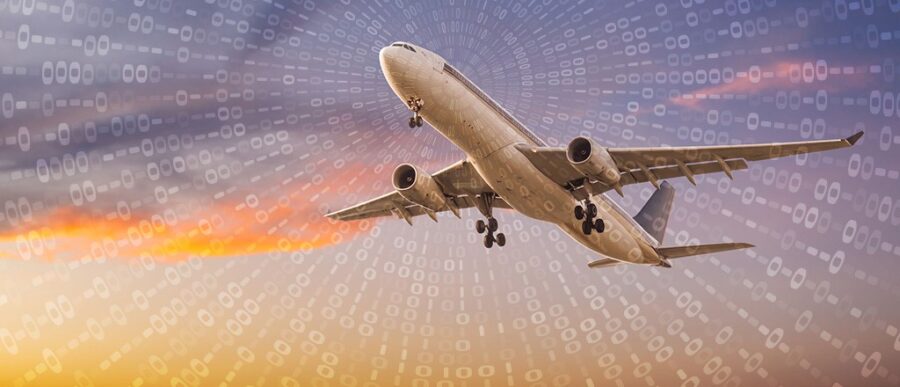In the era of Big Data, businesses must be smart about how they deploy analytics tools to derive deeply valuable insights about their customers. In this video, Knowledge at Wharton spoke with Wharton professor and analytics expert Peter Fader and Raj SivaKumar, head of the travel, technology and strategy unit at WNS, a global business process management company, to discuss the role of analytics in the airline industry.
An edited transcript of the conversation follows.
Knowledge at Wharton: Can you talk about the evolution in the use of analytics for airlines?
Raj SivaKumar: Just to provide some backdrop about the airline industry: It has been perhaps one of the most distressed industries ever since it started. Of the entire travel food chain, airlines make the least amount of profits compared to the other players in the ecosystem. What that has meant — and putting a positive spin to that — is airlines in particular have become the hotbed when it comes to innovation, technology, decision support, optimization, etc. If you look at any leading decision-support system, it’s safe to say that the airlines have led the way — whether it’s a frequent flier program, revenue management systems or scheduling systems — because necessity is the mother of invention.
Now where this all fits in from an analytics standpoint is, in the early days of decision support, analytics played a supporting role. So as revenue management, for example, got enhanced, clearly the advanced revenue management systems required better data, it required more accurate data. But there was very little personalization. Using airline parlance here, it’s looking at PNRs [passenger name records, or] … travel records as opposed to looking at the customers.
“What we have seen in the last, I would say five years or so, is more of an emphasis on personalization.”–Raj SivaKumar, WNS
So while the data collection and data enforcement, so to speak, has been there right from the beginning, what we have seen in the last, I would say five years or so, is more of an emphasis on personalization — understanding the … attributes of the customer more [deeply. I’m] talking about what is it that we can glean from the data that we’ve observed, not just from that customer, but also from the class of customers that look like that customer. And that evolution is pretty marked. That evolution has become more prominent, not only because of the advanced analytical techniques, but also because of advances in data-gathering techniques and the technology that is available for us to parse the data.
Peter Fader: Every other industry owes such an incredible debt of gratitude to the airline industry. As Raj said, they truly led the way. For instance, you look at loyalty programs today. We all take them for granted. They’re ubiquitous. Think about how many different programs you belong to. Every one of those programs, in a way, is paying homage to the airlines. They did it first, they did it best and it continues to be a major strategic weapon there. On a very personal level, I spend a lot of my time these days looking at revenue management or the notion of dynamic pricing.
In fact, I just completed a paper where we applied different dynamic pricing techniques to a major league baseball club. Something like that would have been unthinkable five, 10, 20 years ago. And it really was the airlines who not only brought those words into our vocabulary, but legitimized them and made it possible that, indeed, different people could pay different prices for the very same product. And they made it acceptable and they made it profitable. So those two things alone, loyalty programs and dynamic pricing, are really game-changing for every industry. And it’s remarkable that those innovations, among many others, come from one industry.
Knowledge at Wharton: As airlines increasingly adopt data analytics tools, what are the key factors for success?
SivaKumar: Data analytics is about making better decisions, at the end of the day. And in the airline space, probably more so than any other space, their decisions are all about trade-offs. We are talking about customer centricity, we are talking about revenue enhancement and we are talking about cost reduction. And more often than not, these three objectives are conflicting as opposed to collaborating, if you can say that.
So it is absolutely crucial that the scientists and the practitioners who focus on data analytics understand the trade-offs well, because at the end of the day we’ve got to sell the data analytics program or practice, and make it viable in the industry. And those airlines and practitioners that are able to understand the trade-offs well are the ones that are going to succeed.
Fader: What Raj says is deceptively simple but actually much more complex to implement. This idea of trade-offs, which I completely agree with, sounds simple. In fact, we’ve had statistical techniques for decades that are going to let us measure the trade-offs and understand how people will make those and how they’ll vary across people and how different kinds of contextual factors, such as marketing messages, might impact those trade-offs.
“Data analytics is about making better decisions, at the end of the day.”–Raj SivaKumar, WNS
So from a pure measurement standpoint, it’s easy. That’s a solved problem. But from [the standpoint of] building a business, not just to accommodate those trade-offs but to build it entirely around those kinds of trade-offs … that’s going to mean much more than just having a bunch of smart people who can collect data and crunch numbers. It’s going to mean changing the corporate culture. It’s going to mean changing the kinds of metrics that we use to judge the business. So instead of just looking at things like volume and overall revenue and market share, we’re going to be looking at metrics such as customer lifetime value and customer attention metrics that, by their very nature, represent some of those trade-offs. It’s going to mean a different structure to the organization.
So it’s not enough just to say, ‘We have to embrace trade-offs.’ This has to come from the top down. It has to be the C-level people saying that it is these kinds of trade-offs, it is this notion of customer centricity that’s going to be front and center. And in some sense, if you can get that right, then the analytical capabilities are going to follow quite naturally.
Knowledge at Wharton: Airlines are making alliances with outside partners such as hotel chains, car rental companies and the like, but in the process they do encounter some challenges in these relationships. Can you talk about the nature of those challenges and how they can overcome them?
SivaKumar: It’s a very interesting problem. Airlines have stopped looking at themselves in isolation. They have partnerships with other airlines. They also have partnerships or could be having more partnerships with other players in the ecosystem, whether it’s a car rental company, whether it’s a large travel intermediary, like an OTA [online travel agency], etc.
The customer demands and deserves recognition … and consistency in treatment. But these two become challenges as you look at how do you deal with the customer from … the enterprise’s standpoint. And the problem quite simply is this: Every player in the ecosystem would like to own the customer, to use a parlance.
The way they own the customer for the most part today is through the loyalty programs. The airline frequent flier programs or the hotel loyalty programs or such. And the challenge there is to be able to have an adequate treatment on how information is exchanged, how there is any monetary exchange of a customer that may travel in a certain flight and stay in a certain hotel, and take a certain car rental company. Who benefits more from what treatment? One could argue that the hotel or the airline brings the bulk of the revenue and the car rental company plays a [supporting] role. Whereas the car rental company could argue the other way.
“There’s going to be these tremendous insights arising from [cross-company alliances], and everyone’s going to be better off, not only the partners involved, but the customers as well.”–Peter Fader, Wharton
So the adequate treatment of the cross-company benefits and value … is going to be absolutely important among these companies in their being able to recognize and reward the customer. … How they divvy up the value that the customer brings to the ecosystem amongst themselves is going to be crucial. They’re getting better at it, but a lot more work has to be done.
Fader: The idea of partnerships is one that’s been around forever. And in fact, there were some really bold initiatives happening long before a lot of these operational ideas came to pass. I’m thinking back 25 to 30 years ago. … The problem is, those partnerships were way ahead of their time.
[Today,] the idea of customer centricity, the idea of being able to track individual customers through all those different touchpoints and then allocating their value accordingly, none of that was possible back when United Airlines was buying up certain kinds of hotels and car rental companies. At that point, there were still entirely separate databases for the customers, to the extent they were tracking customers at all, across those three players. There was no way to get that holistic view. And there was no way on any kind of personalized level to serve up differential experiences to customers based on what they were doing with one of the other partners.
Because of this belief in data, because of the belief in analytics, because of the belief in customer centricity, these partnerships are going to start to really bear fruit. And they’re going to do so in a way that’s going to be synergistic to all of the partners, that there’s going to be these tremendous insights arising from it, and everyone’s going to be better off, not only the partners involved, but the customers as well.
Knowledge at Wharton: How can airlines best use social media and other customer level data to drive product differentiation, to boost sales and to provide a superior customer experience?
Fader: Social media, that’s the great unknown. That’s the world that we’re stepping into right now. As always, airlines have been truly at the leading edge of it. It’s interesting because they’re at the leading edge in both ways, which is, on one hand being the producers, being proactive users of social media. So whether it’s hiring armies of people to monitor Twitter and every time they tweet about your name, you’re on it right away, or [producing the actual content.]
“We have an advanced social media analytics tool that captures the social media footprint and maps it to certain airline attributes.”–Raj SivaKumar, WNS
One of the things I just love about airlines is that every Christmas, it seems like lots of different airlines are coming up with some amazing viral videos about how they’re doing some ‘surprise and delight’ activities for customers. Whether it was West Jet in Canada or KLM over in Europe, there are lots of examples of airlines proactively using social media.
But then they’re also on the receiving end of it as well. Because it’s an industry that creates so much passion, you’re going to get viral videos like United breaks guitars. That’s a famous example, but it’s been amazing to see how well not just United Airlines, but airlines in general, have been doing a judo move and take a medium that in some ways can be used against them … and turn it into a real strength.
Now in no way am I suggesting that it’s game over and that they’ve figured this thing out. All I’m saying is that they are leading the way and I think a lot of industries are looking at the airlines to see … how they’re using social media. In the same way, the airlines are being proactive about looking for best practices outside the industry as well.
SivaKumar: Social media is incredible from a couple of different standpoints. One, it’s a rich set of independent data sources compared to the traditional data sources that airlines are used to and other companies are used to. And secondly, it’s spontaneous. There’s a remarkable level of importance that has to be attached to the spontaneity of the data.
To put this in context: Traditionally airlines have invested millions of dollars on conducting surveys, whether in-flight surveys or surveys that nowadays come to your email after the travel has happened, asking, ‘What do you think about the booking process, what do you think about the travel process, the in-flight food, etc.?’ Typically, these surveys are sent a month or week later, whatever the case may be.
But even though the surveys are sent spontaneously, the response is about a month or two after the process happened. For example, a customer may have made the booking six months ago and now you’re asking, ‘Hey, how did the booking process go?’ Now with the advent of social media, the customer is able to spontaneously provide responses — and in a very unconstrained way — about a certain experience. That provides the airlines with a very rich data source on what the world is thinking, or at least what a certain class of customers is thinking, about a particular aspect of the service, good or bad.
At WNS, we have an advanced social media analytics tool that captures the social media footprint and maps it to certain airline attributes — whether it’s meals, whether it’s baggage, whether it’s the check-in process — and compares it with a peer group. You’re able to do all of this in a very unconstrained way and that makes it incredibly powerful compared to the traditional ways because when you look at the service, or even when you look at the complaint data, it’s really a small fraction of the customers that actually take the trouble of complaining. The vast majority of customers take their business to some other airline. Now as you capture this in real time, and you’re able to respond to it in real time, that puts the airlines in a better light and, more importantly, increases the loyalty of your customers.



